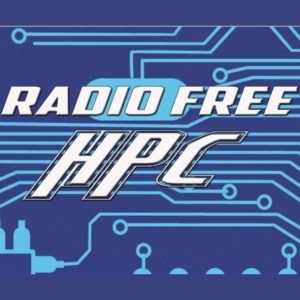
The Sycamore processor. a,Layout of processor showing a rectangular array of 54 qubits (gray), each connected to its four nearest neighbors with couplers (blue). In-operable qubit is outlined.b,Optical image of the Sycamore chip.
In this podcast, the RadioFreeHPC team discusses the Google/NASA paper, titled “Quantum Supremacy Using a Programmable Superconducting Processor”, that was published and then unpublished.
The paper, right in its title, and at least in that draft form, claimed Quantum supremacy. “Doing what?” we hope you ask. Well, nothing particularly significant, and decidedly quantum-friendly. You might even call it “embarrassingly quantum” since quantum is all about probability functions and this experiment samples the probability distribution of a repeated experiment. But it’s not nothing. One scary consequence of quantum supremacy is its ability to readily factorize large numbers which could be used to unscramble encrypted data. But A) this is not what happened, B) it’s not expected to happen any time soon (think years), and C) it will depend on the specific encryption algorithm. We must say, however, that the paper looks pretty good.
Here’s the abstract:
Google AI Quantum and collaborators.The tantalizing promise of quantum computers is that certain computational tasks might be executed exponentially faster on a quantum processor than on a classical processor. A fundamental challenge is to build a high-fidelity processor capable of running quantum algorithms in an exponentially large computational space. Here, we report using a processor with programmable superconducting qubits to create quantum states on 53 qubits, occupying a state space 253∼1016. Measurements from repeated experiments sample the corresponding probability distribution, which we verify using classical simulations. While our processor takes about 200 seconds to sample one instance of the quantum circuit 1 million times, a state-of-the-art supercomputer would require approximately 10,000 years to perform the equivalent task. This dramatic speedup relative to all known classical algorithms provides an experimental realization of quantum supremacy on a computational task and heralds the advent of a much-anticipated computing paradigm.
- LANL gets the First 5,000 Qubit D-Wave. Meanwhile, D-Wave announced that its new 5,000 qubit quantum computer has found its first home at the Los Alamos National Laboratory (LANL). Qubits are different from vendor to vendor in terms of the underlying technology and implementation. Shahin lists several.
- Henry tells the fascinating story of Krebs thwarting the nefarious schemes of a professional hacker who aimed to frame him and actually mailed him narcotics. The mastermind behind it was was arrested and imprisoned for unrelated charges. Henry is really turning this into a good news segment. Dan isn’t encouraged, however.
- Shahin talks about using consumer electronics to build supercomputers, mentioning the recent 1,060 node Raspberry Pi cluster built by Oracle, reminiscent of the one LANL did in 2017. AFRL build a 1,760 node cluster of PlayStations, based on the IBM/Sony/Toshiba Cell processor, in 2010 following similar efforts starting in the mid 2000s. He also recalls similar projects he may have had something to do with: SGI’s Project Molecule and Project Kelvin (for cooling) in 2008 (also here), and also a cluster of JavaStations at Sun in the late 90s.
- Dan discusses a UCLA project to use the thermoelectric effect and build “a device that makes electricity at night using heat radiating from the ground“. Intriguing, but looks a tad too pricey for what it can deliver right now.
- Speaking of Intriguing, Henry talks about DNA storage. Incredible data density, but don’t ask what file system it uses or whether you can have it on a USB stick any time soon. Dan and Shahin seem to have more fun with this topic than Henry!





